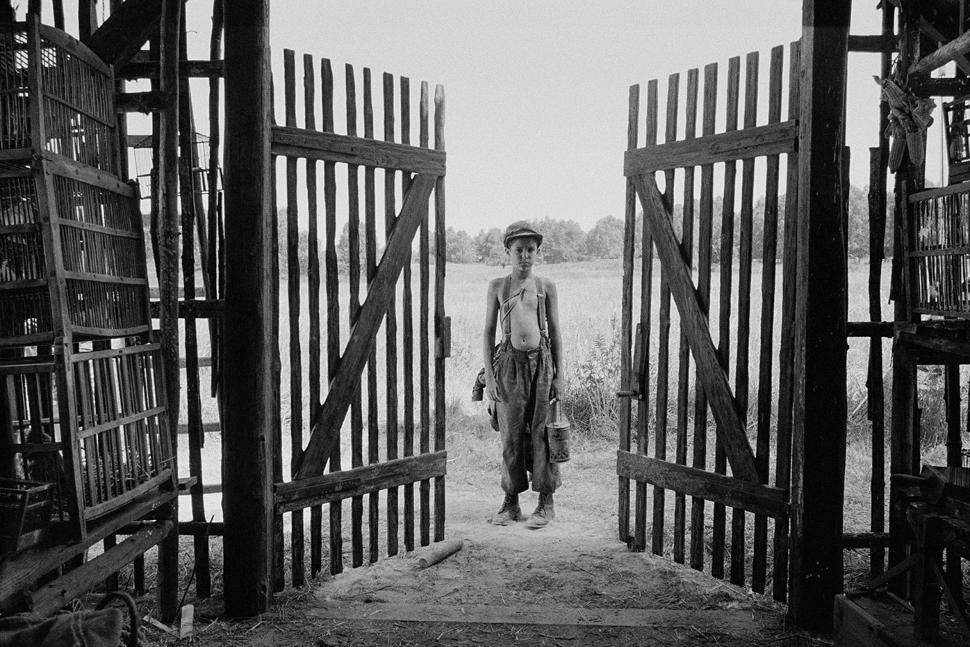The scene from which The Painted Bird takes its name is an odd one. Our protagonist, a young vagabond boy in mid-WW2 Eastern Europe, helps his caretaker slather a captured bird in paint. Afterward, the caretaker releases the bird into the sky as a flock of its own species passes overhead. The flock, unfamiliar with the new color among its ranks, tears the released bird to shreds as the caretaker watches, smiling. He then saunters inside, leaving the little boy to gaze in horror as the painted bird careens to the ground, landing with a wet, dead thud.
This is—by a wide, wide margin—the least distressing act of violence to occur in The Painted Bird, which is based on a 1965 novel of the same name. The film is replete with unimaginable cruelty: child rape, cold-blooded murder, animal torture and bestiality, genocide, spousal abuse, war crimes, infanticide, genital mutilation, all on screen and all graphic. This is not a film for the faint of heart, or possibly for the having of heart, either. Is all this barbarism worth watching? Debatably.
The Painted Bird follows an Eastern European orphan who might be a gypsy, or he might be a Jew—his identity is left intentionally vague. Point is, he lives in a world that doesn’t want him. It’s easy to understand why his potential Jewishness would be a problem, given the ongoing Holocaust, but the danger of his possible Romani descent may require some cultural context. Aside from also being targeted by the Nazis, gypsies were (and still are) persecuted by the general populace of Eastern Europe. I used to teach English in Slovakia, where hatred of the Romani people could be surprisingly overt: it wasn’t uncommon to hear a white Slovak dismiss entire gypsy neighborhoods as “filthy” or worthy of scorn. Even the word “Gypsy” is considered a racial slur by some, though some of my Romani friends have gladly claimed the term. The connotations are complicated, but the animosity is not.
The Painted Bird’s orphan, never in one place for too long, trudges around an unidentified swath of Eastern Europe, placing himself in the care—or servitude—of whomever is willing to feed and house him. These arrangements inevitably end in violence, either witnessed by or committed against the orphan. At three hours long, this spiral into the dregs of material reality can feel dismally one-note. Like last year’s High Life, it uses animals as symbols to convey the bestial lows of human nature—a cat raping another cat before a scene of jealous abuse, for example, or the eponymous bird execution—and at some point, you’re likely to think “okay, I get it: humans are savages”. But there is more to the sadism therein.
The film is engrossingly directed by Václav Marhoul, gorgeously shot by Vladimír Smutný (fittingly, that last name means “sad” in Slovak), and lit with redolent intention. Visually, it’s reminiscent of Tarkovsky, albeit edited at a slightly faster pace, as if to never let up on the onslaught of brutal imagery. The details in the visual language are nearly literary: we spend time with a man staring at a smushed bug on a wall, a bleeding child dragging himself across a field of corpses, a trio of parents staring ambivalently down the barrel of their undoing. Few of these events have a direct impact on the protagonist, but the imagery is powerfully evocative, demanding that you square your conception of the world with its very worst, very real tragedies. No wonder The Painted Bird spends so many shots reflecting on the pain that religious people fear—and the pain they inflict in response. What kind of God would release us painted birds into so hostile a sky? Is He smiling all the while?
But the film as a whole cannot match its most suggestive moments. Its thematic sibling could be An Elephant Sitting Still, a four-hour Chinese film about the nadirs of human suffering. An Elephant Sitting Still works because, in addition to its depressive milieu, it has narrative propulsion and cultural specificity—the characters want something and we want to know if they’ll get it, and we’re experiencing the particular reality of Chinese state capitalism. Conversely, The Painted Bird exists in a state of murky agony, unattached to a specific country or goal, and we’re only left wondering what the next misfortune will be. Is that a journey worth watching? Maybe.
★★★ (3/5)




